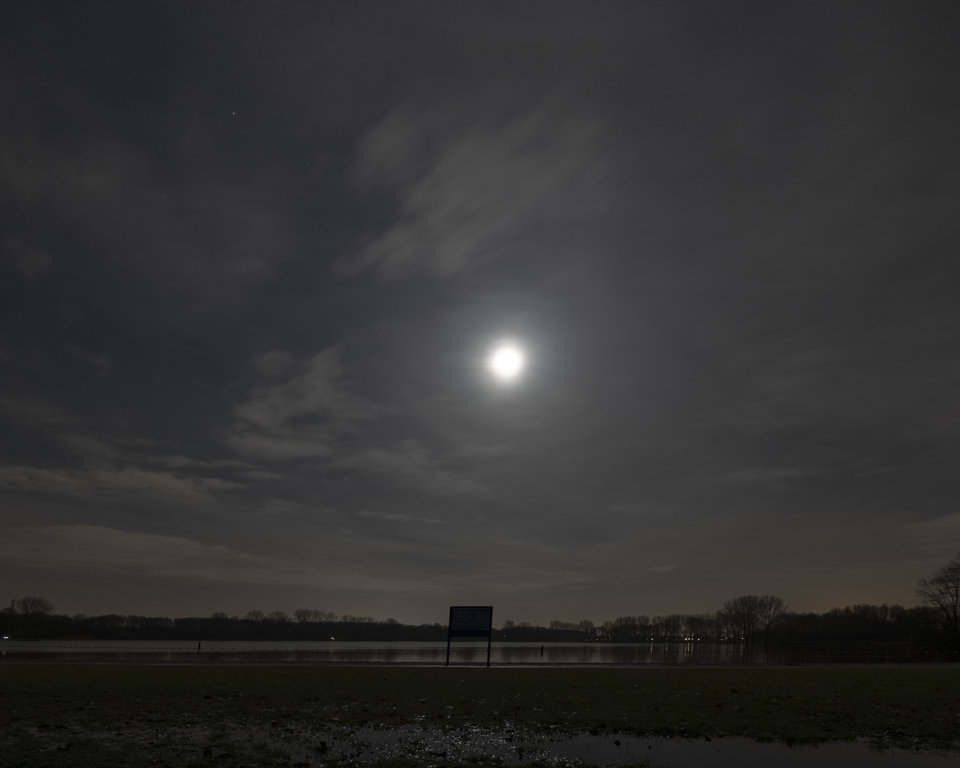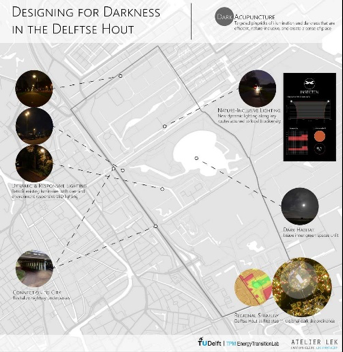Designing for Darkness in the Delftse Hout
Taylor Stone

Designing for Darkness in the Delftse Hout
How can we utilize innovative lighting strategies to lower energy consumption and mitigate light pollution, while also fostering social safety? TPM researcher Taylor Stone has teamed up with lighting design firm Atelier LEK and local stakeholders to develop a masterplan for the Delftse Hout park, envisioned as a testing ground and precedent for responsible urban lighting.
Credit to the photographer: Sander van Iersel
Overview and Results
An open exploration project of the TPM Energy Transition Lab
This open exploration project was focused on the development of a sustainable lighting strategy for Delftse Hout, an important park and recreation space in Delft. You may ask: what does suburban park lighting have to do with the energy transition? I would argue quite a lot. There are estimated to be over 100 million streetlights worldwide, and in the EU they account for approximately 2% of electricity consumption. This includes a great amount of inefficiency: by one estimate, the EU spends over €5 billion per year on “wasted” light alone. What such estimates indicate is that outdoor lighting has a role to play in improving efficiency towards reducing overall energy consumption – a key strategy of the energy transition. And, spaces like the Delftse Hout can serve as a testing ground for innovative designs and policies.
The current introduction of LEDs and “smart” lighting systems offers a means of greatly improving efficiency; the resultant savings could amount to 77 million tonnes of CO2 emissions, once fully realized. Yet, “efficiency” is just one value, which alone is morally ambiguous. And, recent studies into the actual savings achieved within current lighting strategies have cast doubt on the fulfillment of this promise. Thus, what is urgently needed is a new way of thinking about lighting policy and design, before we become locked-in to a new generation of outdoor lighting that exacerbates negative impacts and fails to deliver the energy reductions promised. At a time of anthropogenic climate change – and a time when the far-reaching effects of light pollution are beginning to come to light – we shouldn’t see “efficiency” as a singular goal for our lighting systems. Rather, we need to align our lighting design with a broader set of social and environmental values, including holistic notions of sustainability, biodiversity conservation, and the preservation of the night sky.
This confluence of technological innovations and rising environmental concerns creates fertile ground for the development of new lighting design strategies, and more profoundly a re-imagining of our urban nightscapes. This project contributes to this goal. Through our research into the Delftse Hout, we refined an approach we term dark acupuncture. The name takes inspiration from Jaime Lerner’s idea of urban acupuncture, a bottom-up planning approach positing that a few well-placed “pinpricks” of a certain service, amenity, or structure can begin a process of urban renewal. At its core, dark acupuncture strives to create moments for positive experiences of illumination and darkness, acting as a catalyst for the (ecological) restoration and revitalization of urban nightscapes. Through utilizing innovative techniques such as sensors, dimming, and dynamic lighting that adapts to ambient brightness or seasonal conditions, dark acupuncture offers a means to redefine the meaning of “efficiency” for outdoor lighting, utilizing innovative technologies to design lighting plans that are efficient and nature-inclusive and foster a sense of place. As project collaborator Iris Dijkstra of Atelier LEK says, it’s ultimately about “the right kind of light, at the right times, in the right places.”
Over the last few months we were able to advance these ideas in a few ways:
- A forthcoming article in the International Journal of Sustainable Lighting
- Presenting at the Artificial Light at Night 2021 conference, one of the largest international gatherings of interdisciplinary researchers studying the impacts of artificial lighting
- Submitting a project proposal to develop a comprehensive lighting masterplan for the Delftse Hout
With these outputs we were able to disseminate the design strategy we developed, and take another small step towards the eventual realization of a sustainable lighting plan for the Delftse Hout.
Project Reflections
An “open exploration” is, by definition, a journey towards an unknown destination. In being open, it doesn’t necessarily have a clearly defined end. In being exploratory, it doesn’t have definite boundaries. For the sake of scoping a project or research task, we often create artificial ends and boundaries (knowing they will evolve and change). For this project, it was the realization of a lighting masterplan for the Delftse Hout. In steering towards this ambitious goal, I was able to – among other things – further establish a close collaboration with lighting design firm Atelier LEK. We’re now exploring how we can expand on the ideas developed here, towards a generalizable strategy for urban lighting design.
While successful in producing (academic) results, two important points are worth highlighting. First, these outputs do not fully capture the opportunities the Open Exploration grant provided to discuss and collaborate with a variety of individuals and organizations working on lighting policy and design. The results of such network building are often not immediate or easy to quantify, but nevertheless extremely valuable. Second is that such a large and ambitious project will necessarily take time and patience – while we took productive steps in these last few months, the story is not yet finished.
Overall, I’m very grateful to the TPM Energy Transition Lab for providing the time and space to initiate discussions, build collaborations, and advance strategies for re-imagining the future of urban lighting. Put otherwise: the open exploration continues!
